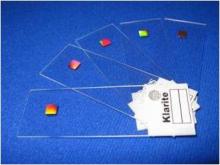 Advances in nanoscale self-assembly techniques have made it possible to design and manufacture nanostructured surfaces with specific optical properties. Materials of this kind are of great interest to the biotech and optoelectronics industries.
Advances in nanoscale self-assembly techniques have made it possible to design and manufacture nanostructured surfaces with specific optical properties. Materials of this kind are of great interest to the biotech and optoelectronics industries.
The nanoplasmonic devices are engineered by placing nanoscale plastic spheres in a regular array on a flat surface. These self-ordered spheres act as a template for the growth of gold and other materials. Once the spheres are dissolved away, the resulting structure is an array of nano-voids - a nanoplasmonic surface - with fascinating nanoscale and macroscopic interactions with light.
 Such nanostructured metal substrates act as aerials for incident light to couple into small nanoparticles or molecules, allowing them to be interrogated at ultra-low concentrations. Healthcare applications are currently under study with the NHS as well as the Forensic Service.
Such nanostructured metal substrates act as aerials for incident light to couple into small nanoparticles or molecules, allowing them to be interrogated at ultra-low concentrations. Healthcare applications are currently under study with the NHS as well as the Forensic Service.
